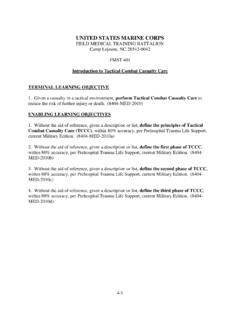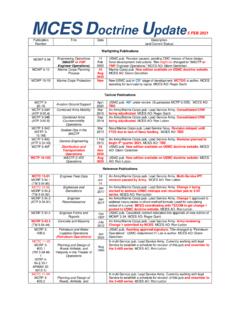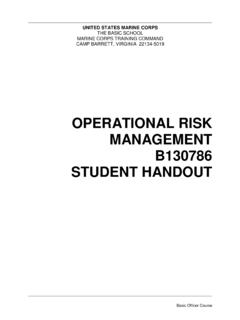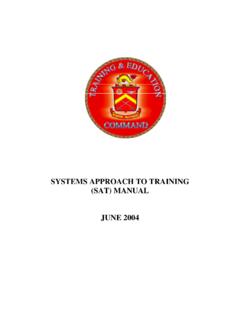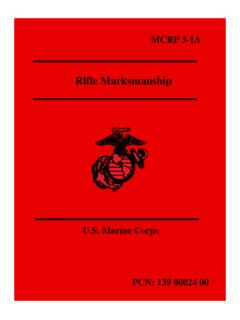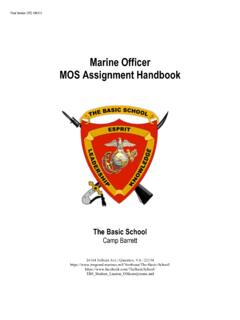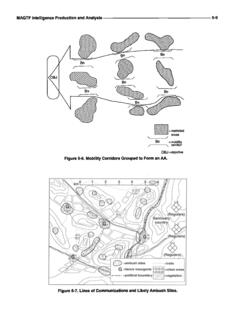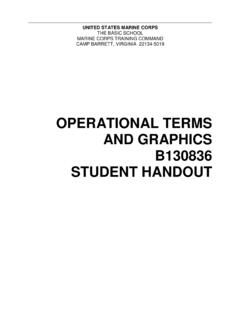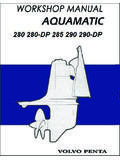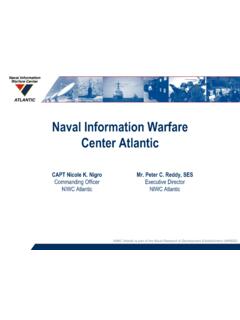Transcription of IMPROVISED EXPLOSIVE DEVICE - United States Marine Corps
1 United States Marine Corps . FIELD MEDICAL TRAINING BATTALION. CAMP LEJEUNE, NC 28542-0042. FMSO 211. IMPROVISED EXPLOSIVE DEVICE . TERMINAL LEARNING OBJECTIVE(S). (1) Given an operating environment with an IED threat, during daylight and limited visibility, identify indicators of IMPROVISED EXPLOSIVE devices (IED) to identify an IED threat. (HSS-MCCS-2017). (2) Given a mission, Commander's guidance and intent, rules of engagement, escalation of force criteria, and a simulated exploded IMPROVISED EXPLOSIVE DEVICE (IED),while serving as an individual in a small unit, react to an exploded IMPROVISED EXPLOSIVE DEVICE (IED) to prevent further casualties and resume the mission.(HSS-MCCS-2019). (3) Given a mission, Commander's guidance and intent, rules of engagement (ROE), escalation of force criteria, non-lethal deterrents, and a simulated suicide IMPROVISED EXPLOSIVE DEVICE (SIED), while serving as an individual in a small unit, react to a suicide IMPROVISED EXPLOSIVE DEVICE (SIED) to prevent friendly casualties and damage to property.
2 (HSS-MCCS- 2018). (4) Given a mission, Commander's guidance and intent, rules of engagement, escalation of force criteria, and an emplaced IMPROVISED EXPLOSIVE DEVICE (IED), while serving as an individual in a small unit, react to an emplaced IMPROVISED EXPLOSIVE DEVICE (IED) to clear individual sector while preventing casualties. (HSS-MCCS-2016). ENABLING LEARNING OBJECTIVE(S). (1) Without the aid of reference and in writing, select the definition of an IED within 80%. accuracy, in accordance with MCIP (HSS-MCCS-2017a). (2) Without the aid of reference and in writing, identify primary indications of an IED. within 80% accuracy, in accordance with MCIP (HSS-MCCS-2017b). (3) Without the aid of reference and in writing, identify common employment techniques of an IED within 80% accuracy, in accordance with MCIP (HSS-MCCS-2017c).
3 (4) Without the aid of references and in writing, identify how to operate in an IED. environment per the references. (HSS-MCCS-2016a). 2-98. (5) Without the aid of reference while wearing individual combat equipment, react to an IED attack, in accordance with JIEDDTF 05-23. (HSS-MCCS-2016b). (6) Without the aid of reference and in writing, define Rules of Engagement within 80%. accuracy, in accordance with MCIP (HSS-MCCS-2018a). (7) Without the aid of reference and in writing, define Escalation of Force criteria within 80% accuracy, in accordance with MCIP (HSS-MCCS-2018b). (8) Without the aid of reference and in writing, identify the tactics to react to a Suicide Bomber, in accordance with MCIP (HSS-MCCS-2018c). (9) Without the aid of reference and in writing, identify the five categories of blast effects on the human body, within 80% accuracy per Prehospital Trauma Life Support, Current Military Edition.
4 (HSS-MCCS-2019a). (10) Without the aid of reference an in writing, identify the pattern of injuries from an EXPLOSIVE DEVICE , within 80% accuracy per Prehospital Trauma Life Support, Current Military Edition. (HSS-MCCS-2019b). (11) Without the aid of reference and in writing, identify the wounding effects of fragmentation, within 80% accuracy per Prehospital Trauma Life Support, Current Military Edition. (HSS-MCCS-2019c). (12) Without the aid of reference and in writing, identify the wounding effects of blast overpressure, within 80% accuracy per Prehospital Trauma Life Support, Current Military Edition. (HSS-MCCS-2019d). 1. DEFINITION OF AN IED. a. IMPROVISED EXPLOSIVE Devices: are those devices that are placed or fabricated in an IMPROVISED manner incorporating destructive, lethal, noxious, pyrotechnic, or incendiary chemicals and designed to destroy, incapacitate, harass, or distract.
5 They may incorporate military weapons, but are normally devised from non-military components. b. COMPONENTS OF AN IED: IED's can vary widely in shape and form. IEDs always share a common set of components that consist of the casing, initiating system, and main charge. (1) Casings can range in size from a cigarette pack to a large truck or airplane. The container is used to help hide the IED and to possibly provide fragmentation. Countless containers have been used as casings, including soda cans, animal carcasses, plastic bags, and vests or satchels for suicide bombers. 2-99. (2) Initiating Systems cause the main charge to function. It can be a simple hard wire (for command detonation) or a radio frequency (RF) DEVICE , such as a cell phone or a toy car remote control.
6 The initiator almost always includes a blasting cap and batteries as a power source for the detonator. Any type of battery can be used (9-volt, AA, or car batteries). Initiating systems are triggered in three ways. (a) Time - timed IEDs are designed to function after a preset delay, allowing the enemy to make his escape or to target military forces which have created a pattern. (b) Command - command-initiated IEDs are a common method of employment and allow the enemy to choose the optimal moment of initiation. They are normally used against targets that are in transit, or where a routine pattern has been established. The most common types of command-initiated methods are with command wires or radio-controlled devices, such as cordless telephones and remote car openers.
7 (c) Victim - victim-actuated IED is initiated by the actions of its victim(s). There are various types of initiation devices, to include pull or trip, pressure, pressure release, movement- sensitive, light-sensitive, proximity, and electronic switches . (3) Main Charge (a) High EXPLOSIVE - main charges are the most commonly encountered in theater. Common explosives used are military munitions, usually 122mm or greater. These items are the easiest to use and provide a ready-made fragmentation effect and multiple main charges together over long or short distances for simultaneous detonation. Common hardware, such as ball bearings, bolts, nuts, or nails can be used to enhance the fragmentation. Propane tanks, fuel cans, and battery acid can and have been added to IEDs to propagate their blast and thermal effects.
8 (b) Chemical - a chemical IED is a main charge with a chemical payload in conjunction with an EXPLOSIVE payload. Chemical IEDs are fabricated to kill or incapacitate victims with a chemical, rather than EXPLOSIVE , effect. Some indicators for chemical IEDs are smaller blasts, odor, gas cloud, and liquid on or near the suspected IED. c. Booby Traps are EXPLOSIVE or non- EXPLOSIVE devices or other materials, deliberately placed to cause casualties when an apparently harmless object is disturbed or a normally safe act is performed. d. Mines are explosives or materials, normally encased, designed to destroy or damage ground vehicles, boats, or aircraft, or designed to wound, kill, or otherwise incapacitate personnel. They may be detonated by the actions of its victims, by the passage of time, or by controlled means.
9 2. IED DETECTION. There are many ways to detect IED's. The best means of detection is your situational awareness. Examples of indicators, locations, and considerations of IEDs include: 2-100. a. Primary IED Indicators - the primary indication of an IED will be a change in the baseline (something new on the route that was not there the previous day). Vigilant observation for these subtle indicators can increase the likelihood of IED detection. Some examples of possible roadside IED indicators may include: (1) Unusual behavior patterns or changes in community patterns, such as noticeably fewer people or vehicles in a normally busy area, open windows, or the absence of women or children. (2) Vehicles following a convoy for a long distance and then pulling to the roadside.
10 (3) Personnel on overpasses. (4) Signals from vehicles or bystanders (flashing headlights). (5) People videotaping ordinary activities or military actions. Enemies using IEDs often document their activities for use as recruitment or training tools. (6) Suspicious objects. (7) Metallic objects, such as soda cans and cylinders. (8) Markers by the side of the road, such as tires, rock piles, ribbon, or tape that may identify an IED location to the local population or serve as an aiming reference for the enemy triggering the IED (such as light poles, fronts or ends of guardrails, and road intersections). (9) New or out of place objects in an environment, such as dirt piles, construction, dead animals, or trash. (10) Graffiti symbols or writing on buildings.

